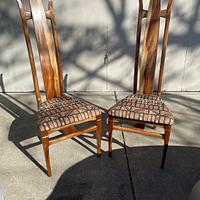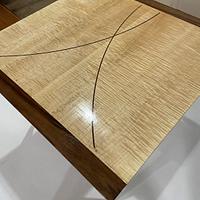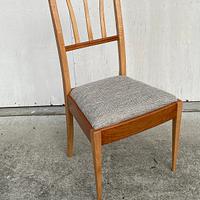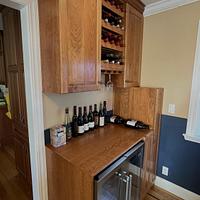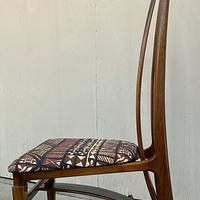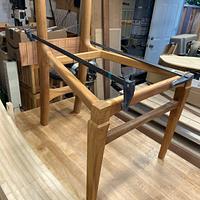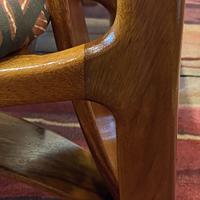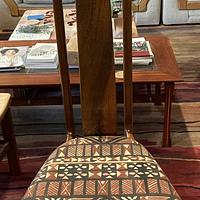Share your craft projects
Make new craft buddies
Ask craft questions
Blog your craft journey
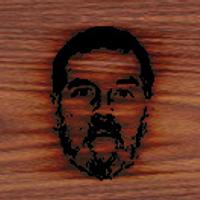
Mike_190930
43 posts
and
4 followers
in almost 3 years
in almost 3 years
More from Mike_190930
Hawaiian Style Side Chair
Some projects come together as a confluence of accidental planning, and sometimes the story of how it came together is as satisfying as the actual build. This project was one of those. There is a companion blog here that goes into a lot more detail on the acquisition of the lumber and the build.
In my wanderings on the web I found Tai Lake’s wonderful web site, and on it his elegantly designed Watcher Chair, in solid Koa Wood. I knew immediately I had to attempt making that design myself . This is my result.
The wood was from a reclaimed Tiki Bar table top, 30” x 40” x 1.5” thick , made of solid Koa Wood, and another slab table top I snagged off of Craig's list. I chose floating tenon joinery to simplify how I cut the parts out of the two table top slabs, and bent laminate glue ups for the curved back and frame rail pieces. Bending forms were CNC cut from 3/4" MDF (awful stuff to be cutting indoors). The bent parts were first soaked in water for about 15 minutes and clamped without glue until dry. That gave them a nearly complete profile which minimized spring back after clamping a second and final time with glue applied. I used clear non-foaming polyurethane glue to avoid creep over time as the residual stress in the wood tries to straighten the boards. Fabricating the bending forms took as much time as the entire rest of the project. That means I am required to retain them and make at least one more of this chair design.
The frame parts are cut on the band saw, mortised on the horizontal CNC router, and joined with hard maple tenons. All parts were treated with water based stain prior to gluing. The glued joints were carved, rasped, and hand sanded to smooth the contours, and re-stained as needed. The curved pieces were then fitted, cut to length (the lower one had a tenon added to the front end) and trimmed to length, re-stained and sanded smooth. Finally, the curved pieces were attached with a pair of 3/8" dowels each top and bottom.
Seat mounts double as corner blocks on the frame, and the 1/2" thick CNC milled seat pan fitted with 10-24 tee nuts.
Lastly the chair is finished with one coat shellac and three coats of Minwax Tung Oil poly varnish.
There were a number of challenges in this project. Choosing where to cut the parts out of the recycled lumber to get matching grain and the best color, cutting and joining the flared joints and smoothing them, and bending the curved pieces all provided learning opportunities.
In my wanderings on the web I found Tai Lake’s wonderful web site, and on it his elegantly designed Watcher Chair, in solid Koa Wood. I knew immediately I had to attempt making that design myself . This is my result.
The wood was from a reclaimed Tiki Bar table top, 30” x 40” x 1.5” thick , made of solid Koa Wood, and another slab table top I snagged off of Craig's list. I chose floating tenon joinery to simplify how I cut the parts out of the two table top slabs, and bent laminate glue ups for the curved back and frame rail pieces. Bending forms were CNC cut from 3/4" MDF (awful stuff to be cutting indoors). The bent parts were first soaked in water for about 15 minutes and clamped without glue until dry. That gave them a nearly complete profile which minimized spring back after clamping a second and final time with glue applied. I used clear non-foaming polyurethane glue to avoid creep over time as the residual stress in the wood tries to straighten the boards. Fabricating the bending forms took as much time as the entire rest of the project. That means I am required to retain them and make at least one more of this chair design.
The frame parts are cut on the band saw, mortised on the horizontal CNC router, and joined with hard maple tenons. All parts were treated with water based stain prior to gluing. The glued joints were carved, rasped, and hand sanded to smooth the contours, and re-stained as needed. The curved pieces were then fitted, cut to length (the lower one had a tenon added to the front end) and trimmed to length, re-stained and sanded smooth. Finally, the curved pieces were attached with a pair of 3/8" dowels each top and bottom.
Seat mounts double as corner blocks on the frame, and the 1/2" thick CNC milled seat pan fitted with 10-24 tee nuts.
Lastly the chair is finished with one coat shellac and three coats of Minwax Tung Oil poly varnish.
There were a number of challenges in this project. Choosing where to cut the parts out of the recycled lumber to get matching grain and the best color, cutting and joining the flared joints and smoothing them, and bending the curved pieces all provided learning opportunities.
Huh? Whadaya mean it ain't "measure once cut twice"?
11 Comments
Beautiful. Having that much Koa is just a dream for me. You did some great work there!
Ryan/// ~sigh~ I blew up another bowl. Moke told me "I made the inside bigger than the outside".
beautiful design mike. the fabric goes with the wood perfectly. question........is it comfortable ?
working with my hands is a joy,it gives me a sense of fulfillment,somthing so many seek and so few find.-SAM MALOOF.
beautiful design mike. the fabric goes with the wood perfectly. question........is it comfortable ?
Thanks Pottz, but full credit to Tai Lake for the design ... I just copied it as best as I could. Yes, comfortable to the extent resting your back on bare wood can be. The width of the back is narrow enough to fit well within the shoulder blades, so not so bad. More of a dinner chair than a TV lounge.
Thanks Pottz, but full credit to Tai Lake for the design ... I just copied it as best as I could. Yes, comfortable to the extent resting your back on bare wood can be. The width of the back is narrow enough to fit well within the shoulder blades, so not so bad. More of a dinner chair than a TV lounge.
Huh? Whadaya mean it ain't "measure once cut twice"?
Great build and nice choice of fabric!
Good looking design and the craftmanship sets it off well. Agree on the fabric also. Great.
Ron
I like it a lot. I have often looked at the three legged style and thought they looked precarious. But this I think is the first I have seen that looks stable, artistic and comfortable all in one. Well done.
I do think you need to make a full set, great looking chair!
Very elegant and well crafted
Mike,
The chair design is great, very nice. Wood and fabric are matched well.
The chair design is great, very nice. Wood and fabric are matched well.
daveg, SW Washington & AZ
Nice job. Smooth lines on it
A very attractive chair. I enjoyed the blog as well.









